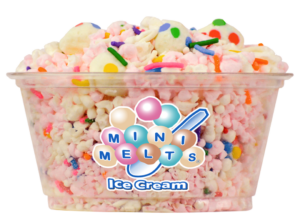With 34,000 distribution points across the contiguous 48 states — ranging from 7-Eleven and Wawa chain convenience stores to ski resorts, zoos, aquariums, and assorted mom-and-pops — ice cream brand Mini Melts has a solid base for selling its cryogenically frozen “beaded” ice cream products, says Dan Kilcoyne, president and CEO, Mini Melts USA & Mini Melts of America, Inc.

Dan Kilcoyne, president and CEO, Mini Melts USA & Mini Melts of America Inc.
“We’ve been growing about 30% year over year for the past two years and already sold over 30 million cups of Mini Melts for 2023,” he says. And with plans for 10 new distribution centers, bringing the total to 33, he says Mini Melts expects to have nearly 10,000 additional distribution points and “a 50% sales increase in 2024.” The family-owned and -operated company doesn’t report revenue figures.
Mini Melts has built its brand on producing and marketing ice cream that is frozen to about minus-40 degrees, a process that produces ice cream with the texture of round beads or popcorn-like kernels in 13 flavors ranging from vanilla, chocolate and strawberry to birthday cake, banana split and cotton candy.
A unique way to manage timely deliveries to stores
Managing timely deliveries of Mini Melts ice cream and meeting each retail location’s inventory needs by volume and flavor assortment, however, relies on a mostly home-grown system of collecting, analyzing and sharing data on what’s selling at each location and systemwide.
 The company uses its own freezer-equipped trucks to deliver its ice cream in cases of individual-serving cups that each retailer then keeps in Mini Melts-branded self-serve freezers or robotic kiosks. Mini Melts also organizes the retail freezers to support inventory management and reordering.
The company uses its own freezer-equipped trucks to deliver its ice cream in cases of individual-serving cups that each retailer then keeps in Mini Melts-branded self-serve freezers or robotic kiosks. Mini Melts also organizes the retail freezers to support inventory management and reordering.
A mobile app lets delivery drivers remotely monitor inventory in Mini Melts self-service kiosks, which transmit sales data to the app each time a kiosk robotic arm fetches an ice cream cup and dispenses it through the kiosk retriever bin.
The company uses a predictive restocking method to manage deliveries and keep each retail location stocked with a full range of flavors and best-selling items. As Mini Melts collects sales data from each retail location, its data analytics team updates a predictive sales model weekly to forecast upcoming delivery volumes.
“Customers never have to call us,” Kilcoyne says.
(This article appears in a longer report on innovation and disruption in B2B ecommerce, B2B Strategy Insights: Standing Out in the B2B Crowd, available for a free download.)
Paul Demery is a Digital Commerce 360 contributing editor covering B2B digital commerce technology and strategy. [email protected].
Sign up
Sign up for a complimentary subscription to Digital Commerce 360 B2B News, published 4x/week. It covers technology and business trends in the growing B2B ecommerce industry. Contact Mark Brohan, vice president of B2B and Market Research Development, at [email protected] and follow him on Twitter @markbrohan.